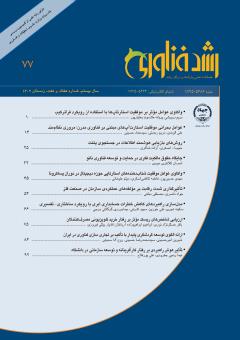واکاوی عوامل موفقیت شتابدهندههای استارتاپی حوزه دیجیتال در دوران پساکرونا
محورهای موضوعی : كارآفريني و مديريت شركتهاي دانش بنيان
مهدی حسین پور
1
*
![]() ,
فاطمه کاظمی اسکری
2
,
میثم علیخانی
3
,
فاطمه کاظمی اسکری
2
,
میثم علیخانی
3
1 - استادیار گروه مدیریت و کارآفرینی دانشگاه رازی
2 - دانشگاه رازی
3 - دانشگاه سیستان و بلوچستان
کلید واژه: شتابدهنده, استارتاپ, دیجیتال, پسا کرونا, کسب و کار,
چکیده مقاله :
هدف از پژوهش حاضر واکاوی عوامل موفقیت شتابدهندههای استارتاپی حوزه دیجیتال در دوران پساکرونا میباشد. این پژوهش ازنظر هدف، در حوزه پژوهشهای کاربردی قرار میگیرد و ازآنجاکه به توصیف متغیرها و روابط بین آنها، شناخت وضعیت موجود و درنهایت ارائه الگو میپردازد، ازلحاظ روش توصیفی- پیمایشی است. جامعه آماری این پژوهش شامل خبرگان مرتبط با شتابدهندههای استارتاپی حوزه دیجیتال در دوران پساکرونا میباشند که بهمنظور رسیدن به اشباع نظری تعداد 25 نفر با روش گلوله برفی عنوان نمونه انتخاب شدند و اطلاعات موردنیاز جمعآوری گردید. برای تجزیهوتحلیل داده-های کیفی و استخراج عوامل تأثیرگذار بر موفقیت شتابدهندههای استارتاپی حوزه دیجیتال و عوامل تأثیرپذیر از آن، از روش تحلیل مضمون (تحلیل تم) استفاده شد. برای شناسایی روابط بین متغیرها، از مدلسازی ساختاری- تفسیری استفادهشده است. یافتههای پژوهش شامل تشریح الگوی موفقیت شتابدهندههای استارتاپ های حوزه دیجیتال و تحلیل نتایج نفوذ همبستگی است. با بررسی نتایج بهدستآمده از نوزده عامل اصلی چابکی شناساییشده مشخص شد که انعطافپذیری ساختار سازمانی و تحلیل دادهها، داراي بیشترین قدرت نفوذ و توانایی پاسخ به مسائل محیطی و توانایی تغییر اهداف کسبوکار، داراي بیشترین وابستگی میباشند.
The purpose of this study is to investigate the success factors of digital startup accelerators in the post-Corona era. In terms of purpose, this research is in the field of applied research, and since it describes the variables and the relationships between them, recognizes the current situation and finally provides a model, it is descriptive-survey method. The statistical population of this study includes experts related to digital accelerator startup accelerators in the post-corona era. In order to achieve apparent theoretical saturation, 25 people were selected as a sample by interview method and the required information was collected. To analyze the qualitative data and extract the factors affecting the success of startup accelerators in the digital field and the factors affecting it, the content analysis method (theme analysis) was used. Structural-interpretive modeling has been used to identify the relationships between variables. The research findings include describing the success pattern of digital startup accelerators and analyzing the results of correlation penetration. Examining the results obtained from the nineteen main factors of identified agility, it was found that the flexibility of organizational structure and data analysis have the greatest influence and the ability to respond to environmental issues and the ability to change business goals, have the greatest dependence
1-Statements of the Leader of the Revolution in a visual connection with production collections.may2020. (In Persian)
2-Dr. Ismail Ghaderifar (1399), Report of the Economic Commission of the Parliament. (In Persian)
3-Kuckertz, A. Brändle, L. Gaudig, A, Hinderer, S, Reyes, C. A. M, Prochotta, A, ... & Berger, E. S. (2020). Startups in times of crisis–A rapid response to the COVID-19 pandemic. Journal of Business Venturing Insights, 13, e00169.
4-Thuriaux-Alemán, B, Salisbury, S. and Dutto, P. R. (2010). “R&D Investment Trends and the Rise of NOCs”. Journal of Petroleum Technology, 62(10): pp. 30–32.
5- Moradi, Sh, Naderi, N, Del(2020) Angizan Sohrab, A Study of the Development Process of FinTech Startups in Iran - Entrepreneurship Development. (47), 121-140. (In Persian)
6- Shahrabi,B, (2019) Modeling the Factors Affecting the Financing of Start-ups (Start-up Businesses) with Demetel Technique-Quarterly Journal of Financial Management Strategy, (25) 61-89. (In Persian)
7- Khashei, V, Asadi, R. (2019), Designing a Strategic Control Model in Internet Startups- Quarterly Journal of Strategic Management Studies. (10)125-139. (In Persian)
8- Nadafi R, Ahmadvand M, (2017) Identifying and prioritizing the drivers of start-up business development (start-ups) using Q methodology - Entrepreneurship Development Quarterly.517-534. (In Persian)
9- Giones, F, Brem, A, Pollack, J. M, Michaelis, T. L, Klyver, K, & Brinckmann, J. (2020). Revising entrepreneurial action in responsetoexogenous shocks: Considering the COVID-19 pandemic. Journal of Business Venturing Insights, 14, e00186.
10- Perrons, R. K. and Donnelly, J. (2012). “Who Drives E&P Innovation? Journal of Petroleum Technology, 64(12), pp. 62–72.
11- Werth, O, Rodriguez, D, Nowatschin, J. (2019). "Challenges of the Financial Industry An Analysis of Critical Success Factors for FinTechs". Twenty-fifth Americas Conference on Information Systems, Cancun in Mexico
12- Lee, I, & Shin, Y. J. (2018). Fintech: Ecosystem, business models, investment decisions, and challenges. Business Horizons, 61(1), 35-46.
13- Sedlacek, P, & Sterk, V. (2020). Startups and employment following the COVID-19 pandemic: A calculator
14- Andreas Kuckertz leif Brandle Anja Gaudig Sebastian Hinderer Carlos Arturo Morales Reyes Alicia Prochotta Kathrin Steinbrink Elisabeth S.C. Berger. (2020). Startups in times of crisis – A rapid response to the covid-19 Pandemic Journal OF Business Venturing Lnsights 169:1-40

